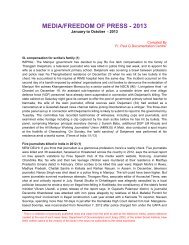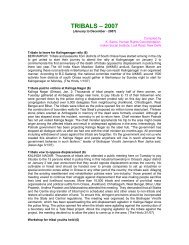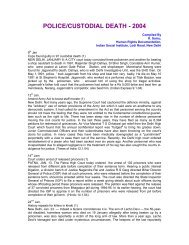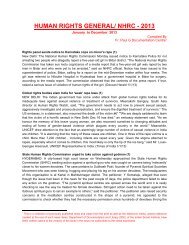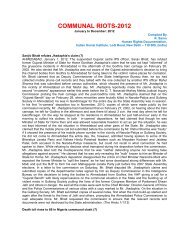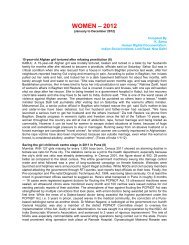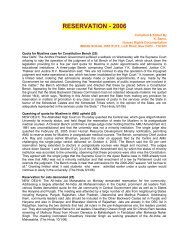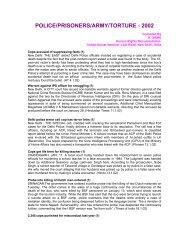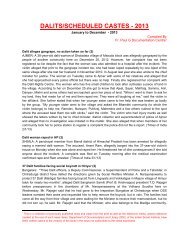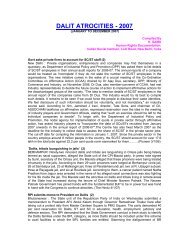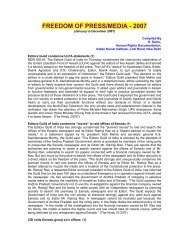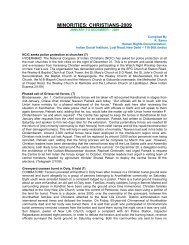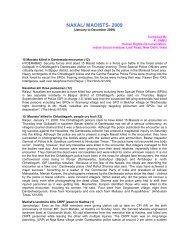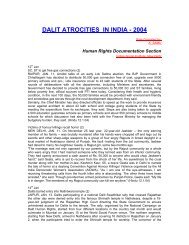Communal Violence and Inter-Community Relations - Indian Social ...
Communal Violence and Inter-Community Relations - Indian Social ...
Communal Violence and Inter-Community Relations - Indian Social ...
Create successful ePaper yourself
Turn your PDF publications into a flip-book with our unique Google optimized e-Paper software.
COMMUNAL VIOLENCE AND INTER-COMMUNITY RELATIONS 29<br />
The conventional explanations available for the progression of the violent<br />
episodes in the decades following the opening of the lock at the disputed<br />
structure at Faizabad also suffer from further conceptual obscurity.<br />
Even before the submission of the Liberhan Commission report, there<br />
was no dearth of detailed narratives of the accounts of the death <strong>and</strong><br />
destruction drawn on diverse episodes of violence from all over India;<br />
they in fact fall much short of underlining the extraordinary nature of<br />
the act i.e. the distantiation followed by mass killing <strong>and</strong> destruction of<br />
the “disparaged others”. Most of the accounts which locate the centrality<br />
of RSS in inciting people to commit such acts of barbarity also depict it<br />
in such a manner in which it appears that killing “others” on the<br />
encouragement of the agency is no different from making them do<br />
other undesirable tasks. In fact one of the most important <strong>and</strong> immediate<br />
tasks for us is to look at the culpability of ordinary people in such<br />
crimes, for so far we have conveniently allowed them to go ahead<br />
freely presuming that they were cajoled to be perpetrators. Drawing<br />
from the writings of Staub (2007), Waller (2007) <strong>and</strong> Goldhagen (1997)<br />
in the context of Nazi Germany, we have reasons including substantial<br />
empirical evidence which suggest that we should not undermine the<br />
actors’ nee perpetrators’ capacity to underst<strong>and</strong>, apprise <strong>and</strong> judge <strong>and</strong><br />
it should also take into account their own personal negotiations with<br />
morality <strong>and</strong> moral framework of connectedness. It needs to be<br />
recognised that we were <strong>and</strong> remain a normal society <strong>and</strong> hence what<br />
made people agree <strong>and</strong> willing to distantiate (at cognitive as well as<br />
spatial level) the “disparaged” others requires a different structure <strong>and</strong><br />
frame of underst<strong>and</strong>ing.<br />
While talking of the nature of evil, Waller (2007) says, “In general<br />
conversation, we easily substitute ‘moral wrongness’ or ‘bad’ for the<br />
term ‘evil’ without any loss of meaning. Even those authors <strong>and</strong> scholars,<br />
who derive <strong>and</strong> make their arguments on the basis of religion <strong>and</strong><br />
philosophy, do not actually define ‘evil’.” Waller (2007) highlights that,<br />
“to specifically define the ‘judgmental’ <strong>and</strong> ‘moralistic’ concept of evil<br />
seems to threaten the academic ideal of ethical <strong>and</strong> value neutrality”.<br />
This is a behavioural definition that focuses on how people act towards<br />
one another; <strong>and</strong> the definition of human evil includes the creation of<br />
conditions that materially or psychologically destroy or diminish people’s<br />
quality of life – their dignity, happiness <strong>and</strong> capacity to fulfil basic<br />
material needs. Such conditions aim to threaten or impact socio-cultural



